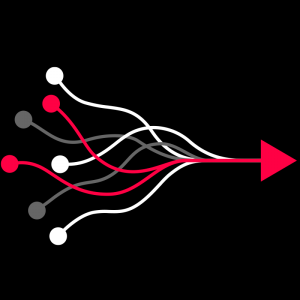Agile marketing, a working method inspired by the agile method and adapted to the specific needs of marketing teams. Agile marketing can be a relevant solution to meet the challenges ofinnovationcustomer needs or marketing productivity. At iQo, we have identified 5 key principles for agile marketing that can be adapted and implemented within marketing teams.

What are the principles of agile marketing (and how can you adopt them)?
85% of marketers plan to increase their adoption of agile practices.
57% of marketers have a formal plan to adopt agile marketing.
Identify subjects that lend themselves to agile marketing and those that don't
The notion of agile is becoming increasingly common in marketing teams. However, it's important to bear in mind that not all projects are conducive to agile marketing.
This is particularly true of the :
- with little added value for the customer
- with low uncertainty (e.g. bid discounting)
- involving too many contributors from outside the company or difficult to involve at the pace required for agile.
Adopt a Test and Learn approach
All too often, marketing teams embark on ambitious projects, involving considerable effort in terms of time and investment, only to find that the offerings developed only partially meet the needs of the market or the expectations of internal stakeholders.
By adopting a Test and Learn approach, and obtaining regular feedback from the various internal and customer stakeholders, project uncertainty is minimized. This makes it possible to :
- Confirm the target's appetitefor the offer
- Ensure that processes are applicable and fluid for internal teams
- Ensure that sales staff find the offer relevant and interesting to propose
Test and Learn means producing prototypes on a regular basis, i.e. deliverables that can be understood and challenged by teams or customers.
A prototype can take many forms: it can be a rough version of the product, or even a mockup of a future web or mobile interface...
Moreover, a prototype is not necessarily finalized in terms of content; a good form may suffice to be understood by the testers and to obtain relevant feedback. These prototypes are then iteratively adjusted throughout the project.
Prioritize actions according to their criticality and importance for the customer
To optimize the relevance of the test and learn approach, it is also important to prioritize the actions to be taken according to their impact and importance for the customer.
In concrete terms, upstream of a project, there are two types of subject to prioritize:
CRITICAL ISSUES
THAT COULD LEAD TO PROJECT FAILURE
- Regulatory constraints in different markets
- Production capacity
- Technical feasibility
TOPICS WITH HIGH
CUSTOMER IMPACT
- Customer promise
- Pricing
- Distribution channels
Of course, this prioritization needs to be adapted to the project in question.
Having identified these key themes, teams can then prioritize them in successive sprints.
A sprint is a predefined, short work sequence (maximum 15 days) during which the project manager and contributors focus on carrying out a specific task, to be completed by the end of the sprint. Read our article dedicated to the Design Sprint to find out more about this approach.
The work resulting from each sprint feeds into subsequent sprints. During the preparation of each sprint, the product manager is provided with the backlog, an exhaustive list of tasks to be developed during the course of the project, in order to have an overall vision and prioritize the actions to be developed.
Putting the customer at the heart of our approach
One of the key principles of agile marketing is to place the customer at the heart of all projects in order to maximize the value delivered to them. We talked about it in this article: Why should listening to customers be a major component of your customer experience strategy?.
Listening to and soliciting the customer's views will help to identify real market needs and validate certain hypotheses. The notion of "customer" is to be understood here in the broadest sense, referring to the buyer, the end-user, or any other stakeholder in the offer (prescriber, etc.).
In concrete terms, each of the different phases of a project is conducive to customer involvement.
IN THE SCOPING PHASE
OF A PROJECT
In order to capture the different needs of customers. For example, listening groups can be organized to gather irritants, wishes or ideas for innovation from certain customer segments.
WHEN DESIGNING
AN OFFER
Involving customers helps validate certain hypotheses. In concrete terms, a panel of customers can be asked to evaluate prototypes or specific functionalities.
AFTER THE LAUNCH
OF AN OFFER / SERVICE
To continue listening to our customers with a view to continuous improvement, we set up hot and cold satisfaction surveys, and analyze feedback from social networks.
Throughout these different stages, the customer plays a multiple role: as scout, decision-maker or tester.
When it proves difficult to mobilize real customers, "customer proxies" can be called upon to carry their voice. A "customer proxy" is an actor with in-depth knowledge of customer expectations, who is considered legitimate to represent customers by the other contributors to the project. Sales teams or customer service experts, for example, can play this role.
Adapting internal collaboration methods
When managing projects, and in particular when designing new offers, marketing teams have to collaborate with many other departments: sales, legal, finance, strategy... all essential expertise, but which makes project management more complex. As contributors often have limited availability to contribute at the pace desired by the project manager, the latter finds himself running several projects simultaneously. As a result, each project takes longer to complete, and time-to-market suffers.
WORK IN
SPRINT MODE
Agile marketing calls for a rethinking of this organizational mode: projects are organized and divided into sprints, enabling a large number of experts to be mobilized and identified in advance to ensure their availability for the work sessions required by the sprint.
The project manager is mobilized full-time on the project, to ensure that he himself does not become a bottleneck for the project.
ORGANIZE
PROJECT TEAM
To take the approach a step further, we can also consider organizing the project by team rather than by business line.
In this case, theteam has all the skills (marketing, IS, legal, etc.) needed to bring the project to fruition, and is dedicated to it.
This kind of organization is effective, but radical: it also implies more structural organizational and cultural changes.
Working in small, multi-skilled teams
Finally, no matter how you choose to collaborate on your project, it's important to keep your team size manageable. Remember the "2-pizza team" rule advocated by Jeff Bezoz.
Thehybridization of skills can thus appear as a solution for maximizing the expertise mobilized while limiting the number of stakeholders.
For example, at iQo, the notion of hybridizing skills is at the heart of our consultants' development approach. They are coached and trained in a variety of areas of expertise, including data, innovation and impact, to enhance their ability to bring different skills to bear on projects.
Further information

Design sprint: understand it all in 5 minutes
The design sprint is an innovation process that enables teams to rapidly create and test product or service ideas. It

What is business design?
Business design is an approach that combines the methodology of design thinking with the tools of business analysts to respond to business issues (definition

10 keys to an efficient marketing organization
In both BtoB and BtoC markets, the marketing organization and its perimeter must evolve to cope with the rapid and continuous changes in their environment: A

